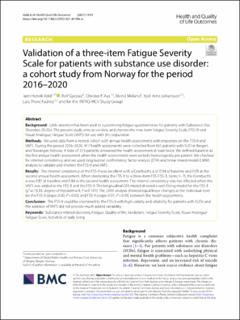| dc.contributor.author | Vold, Jørn Henrik | |
| dc.contributor.author | Gjestad, Rolf | |
| dc.contributor.author | Aas, Christer F. | |
| dc.contributor.author | Meland, Eivind | |
| dc.contributor.author | Johansson, Kjell Arne | |
| dc.contributor.author | Fadnes, Lars Thore | |
| dc.date.accessioned | 2022-01-24T14:56:27Z | |
| dc.date.available | 2022-01-24T14:56:27Z | |
| dc.date.created | 2021-07-07T12:15:16Z | |
| dc.date.issued | 2021-03-02 | |
| dc.identifier.issn | 1477-7525 | |
| dc.identifier.uri | https://hdl.handle.net/11250/2839031 | |
| dc.description.abstract | Background: Little attention has been paid to customising fatigue questionnaires for patients with Substance Use Disorders (SUDs). The present study aims to validate and shorten the nine-item Fatigue Severity Scale (FSS-9) and Visual Analogue Fatigue Scale (VAFS) for use with this population.
Methods: We used data from a nested cohort with annual health assessments with responses on the FSS-9 and VAFS. During the period 2016–2020, 917 health assessments were collected from 655 patients with SUD in Bergen and Stavanger, Norway. A total of 225 patients answered the health assessment at least twice. We defined baseline as the first annual health assessment when the health assessments were sorted chronologically per patient. We checked for internal consistency, and we used longitudinal confirmatory factor analysis (CFA) and linear mixed model (LMM) analysis to validate and shorten the FSS-9 and VAFS.
Results: The internal consistency of the FSS-9 was excellent with a Cronbach’s α of 0.94 at baseline and 0.93 at the second annual health assessment. When shortening the FSS-9 to a three-item FSS (FSS-3, items 5–7), the Cronbach’s α was 0.87 at baseline and 0.84 at the second health assessment. The internal consistency was not affected when the VAFS was added to the FSS-3 and the FSS-9. The longitudinal CFA model showed a well-fitting model for the FSS-3 (χ2 = 13.33, degree of freedom = 8, P = 0.101). The LMM analysis showed equal linear changes at the individual level for the FSS-3 (slope: 0.00, P > 0.05) and FSS-9 (slope: 0.01, P > 0.05) between the health assessments.
Conclusion: The FSS-9 could be shortened to the FSS-3 with high validity and reliability for patients with SUDs and the addition of VAFS did not provide much added variability. | en_US |
| dc.language.iso | eng | en_US |
| dc.publisher | BMC | en_US |
| dc.rights | Navngivelse 4.0 Internasjonal | * |
| dc.rights.uri | http://creativecommons.org/licenses/by/4.0/deed.no | * |
| dc.title | Validation of a three-item Fatigue Severity Scale for patients with substance use disorder: a cohort study from Norway for the period 2016–2020 | en_US |
| dc.type | Journal article | en_US |
| dc.type | Peer reviewed | en_US |
| dc.description.version | publishedVersion | en_US |
| dc.rights.holder | Copyright 2021 the authors | en_US |
| dc.source.articlenumber | 69 | en_US |
| cristin.ispublished | true | |
| cristin.fulltext | original | |
| cristin.qualitycode | 1 | |
| dc.identifier.doi | 10.1186/s12955-021-01708-w | |
| dc.identifier.cristin | 1920673 | |
| dc.source.journal | Health and Quality of Life Outcomes | en_US |
| dc.identifier.citation | Health and Quality of Life Outcomes. 2021, 19, 69. | en_US |
| dc.source.volume | 19 | en_US |

